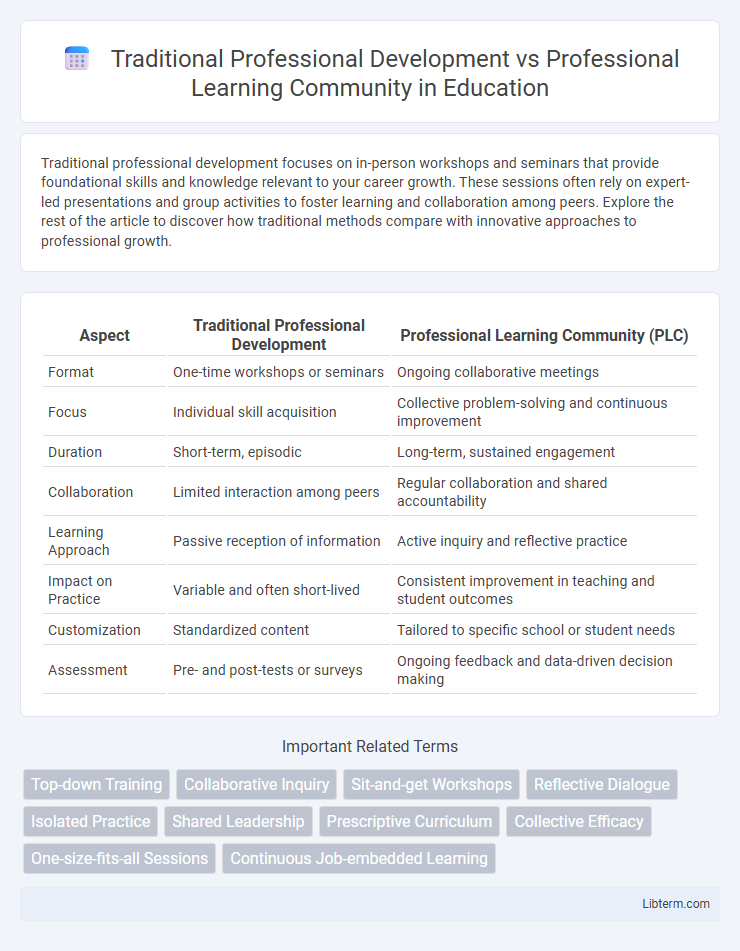Traditional professional development focuses on in-person workshops and seminars that provide foundational skills and knowledge relevant to your career growth. These sessions often rely on expert-led presentations and group activities to foster learning and collaboration among peers. Explore the rest of the article to discover how traditional methods compare with innovative approaches to professional growth.
Table of Comparison
| Aspect | Traditional Professional Development | Professional Learning Community (PLC) |
|---|---|---|
| Format | One-time workshops or seminars | Ongoing collaborative meetings |
| Focus | Individual skill acquisition | Collective problem-solving and continuous improvement |
| Duration | Short-term, episodic | Long-term, sustained engagement |
| Collaboration | Limited interaction among peers | Regular collaboration and shared accountability |
| Learning Approach | Passive reception of information | Active inquiry and reflective practice |
| Impact on Practice | Variable and often short-lived | Consistent improvement in teaching and student outcomes |
| Customization | Standardized content | Tailored to specific school or student needs |
| Assessment | Pre- and post-tests or surveys | Ongoing feedback and data-driven decision making |
Understanding Traditional Professional Development
Traditional Professional Development often involves one-time workshops or seminars led by external experts, focusing on delivering specific skills or knowledge in a top-down approach. This method typically lacks ongoing collaboration and reflection among educators, resulting in limited long-term impact on teaching practices. Understanding this approach highlights its emphasis on passive learning rather than continuous, interactive, and context-specific professional growth.
Defining Professional Learning Communities
Professional Learning Communities (PLCs) are collaborative groups of educators who work together to improve teaching skills and academic performance through ongoing dialogue and shared goals. Unlike Traditional Professional Development, which often involves one-time workshops or seminars, PLCs emphasize continuous, job-embedded learning centered on student outcomes. The core of PLCs lies in collective inquiry, reflective practice, and data-driven decision making to foster sustained school improvement.
Key Differences Between Traditional PD and PLCs
Traditional Professional Development (PD) typically involves one-time workshops or seminars focused on skill acquisition delivered by external experts, with limited follow-up or collaboration. Professional Learning Communities (PLCs) emphasize ongoing, collaborative learning among educators within a school, promoting shared goals, collective inquiry, and continuous improvement aligned with student outcomes. Unlike traditional PD, PLCs foster sustained dialogue, reflection, and data-driven decision-making, creating a culture of professional growth embedded in daily practice.
Goals and Outcomes of Each Approach
Traditional professional development typically aims to deliver specific skills or knowledge through workshops or seminars, resulting in short-term improvements and immediate application of techniques. Professional Learning Communities (PLCs), on the other hand, emphasize ongoing collaboration, reflection, and shared responsibility among educators to foster continuous growth and systemic change in teaching practices. The outcomes of PLCs include enhanced student achievement, sustained professional growth, and a culture of collective accountability, contrasting with the limited scope and episodic nature of traditional development.
Teacher Engagement and Collaboration
Traditional professional development often involves isolated workshops with limited teacher engagement and minimal ongoing collaboration, leading to transient knowledge retention. Professional Learning Communities (PLCs) promote continuous, collaborative teacher engagement through regular meetings and shared goals, fostering deeper instructional improvement. Research indicates that PLCs significantly enhance teacher collaboration, reflective practice, and sustained professional growth compared to conventional training models.
Impact on Student Achievement
Traditional professional development often involves one-time workshops or lectures that provide limited opportunity for ongoing collaboration, resulting in minimal impact on student achievement. In contrast, Professional Learning Communities (PLCs) foster continuous teacher collaboration, data-driven instruction, and shared accountability, leading to significant improvements in student performance. Research demonstrates that PLCs enhance instructional practices and student outcomes by promoting collective teacher efficacy and sustained professional growth.
Professional Growth: Static vs. Dynamic Learning
Traditional professional development often involves static, one-time workshops that limit sustained professional growth by delivering fixed content without ongoing support or collaboration. In contrast, Professional Learning Communities (PLCs) foster dynamic learning environments through continuous, collaborative engagement, encouraging reflective practice and adaptation to evolving educational needs. This dynamic approach promotes deeper professional growth by integrating real-time feedback and shared expertise.
Challenges in Implementation
Traditional professional development often faces challenges such as limited engagement, one-size-fits-all training, and lack of follow-up support, leading to minimal impact on instructional practices. Professional learning communities (PLCs) encounter obstacles including time constraints for regular collaborative meetings, inconsistent participation, and difficulties in sustaining a culture of trust and shared responsibility among educators. Both approaches require strategic leadership, adequate resources, and ongoing commitment to overcome barriers and ensure effective teacher growth and student outcomes.
Measuring and Sustaining Success
Traditional professional development often relies on one-time workshops with limited follow-up, making it difficult to measure long-term impact and sustain success. Professional Learning Communities (PLCs) emphasize continuous collaboration, data-driven reflection, and shared accountability, enabling educators to track progress and adapt strategies over time. Sustained success in PLCs is driven by ongoing support structures, frequent performance assessments, and collective problem-solving, resulting in measurable improvements in teaching practices and student outcomes.
Choosing the Right Model for Your School
Choosing the right model for your school depends on aligning goals with outcomes: Traditional Professional Development offers structured, expert-led training sessions focused on specific skills, while Professional Learning Communities (PLCs) emphasize collaborative, ongoing peer learning tailored to teachers' needs. Research shows PLCs foster sustained improvement in instructional practices and student achievement through shared responsibility and reflective dialogue. Schools aiming for long-term growth and adaptability often benefit more from implementing PLCs rather than one-time workshops.
Traditional Professional Development Infographic

 libterm.com
libterm.com